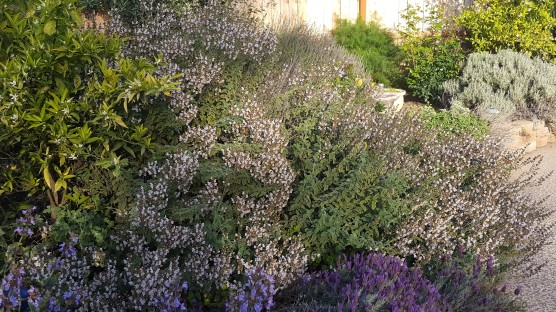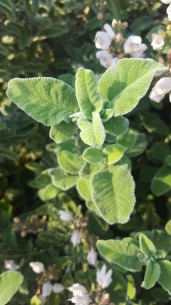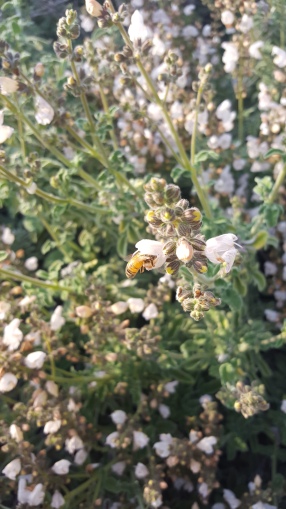 The rise in popularity of and interest in growing heirloom fruits and veggies has extended to the herb garden. However, there are some that remain well-kept secrets that really shouldn’t be.
The rise in popularity of and interest in growing heirloom fruits and veggies has extended to the herb garden. However, there are some that remain well-kept secrets that really shouldn’t be.
(All links open a new page, so you won’t lose your spot when you look around! Get information on gardening and cultural traditions, recipes, stories, and more!)
*A handy growing summary chart is at the end of the article.*
 When most people think of sage, they likely think of garden sage, the plant that produces the very aromatic culinary staple herb. They may even think of some of the colorful variations like purple sage or golden sage. They are very likely NOT thinking about Greek Sage, even though the sage purchased at the store probably has a large amount of this plant’s leaves ground in, as well.
When most people think of sage, they likely think of garden sage, the plant that produces the very aromatic culinary staple herb. They may even think of some of the colorful variations like purple sage or golden sage. They are very likely NOT thinking about Greek Sage, even though the sage purchased at the store probably has a large amount of this plant’s leaves ground in, as well.
Greeks have been using this herb for thousands of years for a variety of purposes, including cosmetic and medicinal, in addition to culinary. One of the more common uses is to make a tea, called faskomilo, from the dried leaves. The levels of flavor compounds are higher in Greek Sage than garden sage, so it doesn’t take a lot. Usually, the leaves are steeped in hot water until the desired strength is reached, then the tea will be sweetened with honey and have a squeeze of lemon juice added.
 Like other plants in the Salvia group, Greek Sage is highly drought tolerant. In fact, the plants need well-draining soil and indirect water in order to ensure that the roots don’t suffer from rot due to excess moisture. If you rely on sprinklers to provide water during dry spells, make sure that they aren’t aimed directly at the plant, but instead are gently sprinkling over it.
Like other plants in the Salvia group, Greek Sage is highly drought tolerant. In fact, the plants need well-draining soil and indirect water in order to ensure that the roots don’t suffer from rot due to excess moisture. If you rely on sprinklers to provide water during dry spells, make sure that they aren’t aimed directly at the plant, but instead are gently sprinkling over it.
Greek Sage is native to the Mediterranean region, and therefore prefers a similar type of climate. Give it full sun, preferably at least 6 hours a day. Despite the fact that it can handle extremely hot daytime summer temperatures, it can also tolerate some degree of frost in winter. It has survived unscathed when the nighttime lows dipped into the upper 20’s in our yard, and reportedly can tolerate down to 20 F.
Despite some statements that Greek Sage grows only about 2 feet tall and wide (Wikipedia, I’m looking at you), I’m here to tell you that it will take up a lot more space than that if it has really good growing conditions. Ours reached about three feet tall and had a spread of at least five feet. It can be kept better in check with regular winter pruning, or it can be grown in a large container to reduce it’s overall size.
 Each spring when the weather starts to warm up, Greek Sage puts on an amazing display of dainty, light pink flowers. These blooms are a major bee attractant, so you’ll be helping pollinators if you have one in your yard. However, the downside is that Greek Sage freely produces seeds from those flowers, which will often grow into more plants. If you have other sage plants nearby, Greek Sage will also readily hybridize with them and so the seedlings won’t necessarily be the same. If you want to reduce the number of seedlings that sprout up, you will need to stay on top of trimming the spent flower heads before the seeds mature.
Each spring when the weather starts to warm up, Greek Sage puts on an amazing display of dainty, light pink flowers. These blooms are a major bee attractant, so you’ll be helping pollinators if you have one in your yard. However, the downside is that Greek Sage freely produces seeds from those flowers, which will often grow into more plants. If you have other sage plants nearby, Greek Sage will also readily hybridize with them and so the seedlings won’t necessarily be the same. If you want to reduce the number of seedlings that sprout up, you will need to stay on top of trimming the spent flower heads before the seeds mature.
There is one other aspect of Greek Sage that you likely won’t find mentioned on other websites, and that is the odor of the leaves. Greek Sage has a very strong camphor smell when the leaves are rubbed. Some people (me) find it a bit overwhelming, while others (the Old Man) aren’t bothered by it at all. Thankfully the smell only occurs when the leaves are brushed, releasing their oils. It is not something that you would smell otherwise. However, when I would trim the plant, it was unavoidable.
Plant Summary:
- Perennial
- Evergreen
- Height: up to three to four feet
- Width: up to 3-5 feet
- Sun: full sun, can tolerate some morning or afternoon shade
- Water: light, drought tolerant, do not let sprinklers hit the plant directly
- Soil pH: neutral to slightly acidic
- Soil type: amend heavy clay or loose sandy soil
- Key nutrients: fertilize as you would for other flowers, but likely won’t need it
- Planting time: best to start seeds or transplant in the spring
- Zones: 9+, but can tolerate zone 8 if in a warm location in winter


This is a new one to me, and I know a few sages.
LikeLiked by 1 person
Actually, I just asked, and there is some out there, but we do not know it as Greek sage, but just sage. I think the bloom might be a bit more pinkish.
LikeLiked by 1 person
My pictures didn’t quite capture the pink, but yes, the flowers are a light pink. It was also known as Salvia triloba, since it has leaf clusters in threes. It’s smell is really strong when the leaves are rubbed, and it is fuzzy, unlike many of the other sages I’ve come across.
LikeLiked by 1 person
There are several species at one of the main gates here. I do not know why there are several different kinds, but they are nice. There is even white sage there.
LikeLiked by 1 person